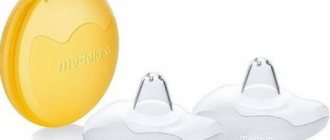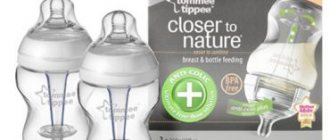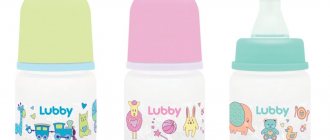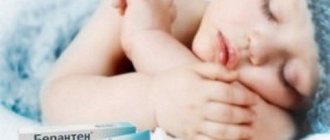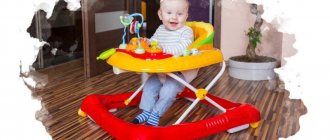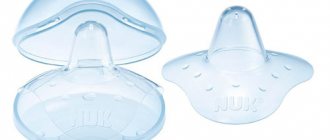The value of breastfeeding is undeniable. Breast milk has an incredibly beneficial effect on the growth and development of a little person. Even the most expensive and high-quality dry formula does not have the qualities that are characteristic of breast milk. However, not every new mother can boast of trouble-free feeding.
Women can experience a wide variety of problems during lactation, ranging from poor milk production to extremely unpleasant sensations while feeding the baby. In order to make their life easier and reduce the child’s anxiety, mothers often try all sorts of ways to get rid of uncomfortable sensations. So, many people buy special pads for breastfeeding. Are these devices useful? What advantages do they have? Isn't this harmful for a woman's breasts and the formation of a child's bite? In order to understand the whole situation, you will have to answer the questions posed.
When and why are nipple shields needed?
First of all, it should be noted that the need to purchase additional accessories, often recommended in the maternity hospital or advertising brochures, is usually exaggerated. The special shape of the mother's nipples and cracks that often appear at the initial stage of feeding are not an obstacle to successful feeding - all these difficulties are temporary and easily overcome. However, there are still situations when the use of overlays is justified.
Cases when using breast pads is necessary
- Unbearable pain when feeding, especially in first-time mothers. Non-healing nipple injuries, combined with a mother’s low pain threshold, in some cases can lead to the fact that a woman, exhausted by constant discomfort, simply refuses to breastfeed and is ready to switch the baby to formula. Of course, when choosing between artificial feeding and feeding with pads, you should give preference to the second option.
- Abnormal structure of the infant's oral cavity (short frenulum of the tongue). The child’s tongue is actively involved in feeding, and in the presence of such a pathology, the baby is not able to properly grasp the mother’s nipple and properly stimulate it. In this case, an alternative to cutting the frenulum can be overlays.
- Feeding “special groups” of newborns: premature, weakened, children with central nervous system damage. Such babies are often physically not ready to fully suckle, they lose weight, the mother’s lactation is also not properly stimulated, and under pressure from doctors the child is transferred to formula. Breastfeeding pads make it easier for the baby to suck and thereby preserve the mother's milk he needs in sufficient quantities.
- Transition from artificial to breastfeeding. If a newborn is forced to bottle feed for some time, there is a danger of getting used to the nipple and subsequent refusal of the breast. In this situation, a breastfeeding shield can be an effective intervention to restart breastfeeding.
What are silicone pads used for?
First of all, you should pay attention to when the use of silicone pads would be appropriate. Of course, we are talking about medical indications here.
So, special breastfeeding pads can be used when:
- The period of lactation has begun. Undeveloped breasts react very painfully to milk production. A common mistake is incorrectly attaching the baby to the breast, which causes pain.
- The baby refuses to take his mother's breast. This happens if the mother, for some reason (cold, taking antibiotics, etc.) bottle-fed the child for a long time. The baby is used to drinking milk without making much effort, so repeated application to the breast can ruin his mood. Using silicone pads in this case will make the task easier for the baby.
- Cracks appeared on the chest. This occurs when a pregnant woman did not develop her nipples before giving birth.
- During the birth process, the baby received birth injuries, as a result of which the child’s nervous system develops a little more slowly. This, in turn, provokes sluggish and slow sucking.
- The child was born premature or weakened. In the first days after birth, such babies simply do not have enough strength to drink milk from their mother’s breast on their own.
- The baby's first teeth begin to appear. At this time, the child is already in a capricious mood, and the constant desire to “scratch” his teeth does not bypass his mother’s nipples. It’s quite easy to imagine this feeling when a hungry baby clings with all his strength to the nipple with barely visible teeth. The pleasure, let's say, is not pleasant.
- The structure of the nipples does not correspond to the norms (too large or elongated, flat and sunken).
- The structure of the baby's oral cavity is disturbed - a shortened frenulum.
These are the main and most common cases when using silicone breastfeeding breastfeeding breastfeeding breastfeeding breastfeeding breastfeeding breastfeeding pads. However, it is important to remember that the use of such devices is an exceptional measure and should be used only in cases of extreme necessity.
Disadvantages of using breast pads
As we have already noted, the use of devices such as pads is not always justified, and many breastfeeding experts strongly recommend using them only as a last resort, while carefully monitoring the baby’s behavior and weight gain.
There are indeed reasons for a negative attitude:
- The pads are addictive for both the baby and the nursing woman. Often, the child subsequently refuses to suckle without pads, and for the mother they become a familiar accessory, since the nipples remain sensitive and there is no natural adaptation to the sensations during feeding.
- No matter how tightly the pad fits, air still gets under it, which can lead to digestive problems in the baby.
- The pads require special care and regular sterilization, otherwise they can become a source of infection for mother and baby.
- Silicone nipples present additional difficulties when feeding. Like any other accessories, they tear, get lost, can be difficult to find at night and difficult to put on during unplanned feeding, for example, on the street.
- There are studies that indicate the negative impact of pads on the milk supply of a nursing mother. This is probably due to insufficient stimulation of the nipples during feeding.
Breast pads for feeding - pros and cons
Selection of overlays for hot water
Products are latex or silicone. The first material is natural, created from the sap of the tropical Hevea tree. The second is a synthetic polymer. Both options are hypoallergenic and non-toxic. In general, their characteristics are similar, but there are still differences:
- Silicone pads are tighter, less susceptible to deformation and therefore last longer.
- Latex pads should not be treated with boiling water, as they will wrinkle and crack. This does not happen with silicone products.
- Latex models are much cheaper than silicone ones.
There is another option on sale - a combined one. These attachments have the tip that the baby sucks on, made of latex or silicone, and the base, adjacent to the areola of the woman's breast, made of rubber. Such products are the cheapest, but it is still better not to choose them - they have a strong rubber smell, quickly break down, and can cause an allergic reaction.
Philips Avent
Philips Avent nipple covers (UK) are made of thin, soft silicone, tasteless and odorless. The range includes products in only two sizes - small and standard. The price for a package of 2 pieces is approximately 650 rubles.
Among the disadvantages that may be important for someone is the large diameter of the pad and the miniature cutout for the nose of babies, so during feeding the baby does not come into contact with the skin of his mother’s breast. Also, reviews note that there are quite large holes (1 in the center and 3 along the perimeter of the artificial nipple), which may result in excessive milk leakage.
Medela
Swiss Medela onlays are made entirely of ultra-thin silicone. Very light. Each (2 pieces in one package) weighs only 20 grams. They have a fairly large cutout in the upper part, so when feeding, the baby rests not against the synthetic material, but against the mother’s skin. They have 4 holes for milk to flow out, arranged in a diamond shape.
The box costs approximately 730 rubles. The recommended period of daily use is 5 months, then it is better to change the pads for new ones. When washing, you can use boiling water, which allows you to more thoroughly disinfect the product.
Chicco
Italian product made of silicone. There is a box with 2 pcs. within 620 rub. The kit includes a convenient container in which you can store the pads or take them with you on the road (a box with dimensions of 6x12x13 cm will not take up much space in your bag). By the way, this packaging is suitable for sterilization in the microwave.
The downside of Chicco pads is that they are big. The range does not include products for premature babies or for women with nipples smaller than 20 mm. One of the advantages is the ultra-thin material, which provides a tight grip on the breast and guarantees the absence of air bubbles in the milk sucked by the baby.
Other
Philips Avent, Medela, Chicco are the leaders among breast pads. They are considered the highest quality and safest. But they also cost more than others. If you need to choose cheaper models, then you should take a closer look at the following brands:
- BabyOno (Poland) – combined pads. The base is made of rubber, and the “nipple” is made of silicone. Price – from 170 rub.
- “World of Childhood” (China) – latex nozzles, quite hard but durable. They cost from 130 rubles.
- Ameda (India) – these pads are considered massage pads due to their corrugated surface. Stimulation during feeding allows you to produce more milk. Price – about 450 rub.
- “MaM” (Austria) – silicone nozzles with 5 holes for the outflow of milk. Available in two sizes. Cost from 250 rub.
- Pigeon (Japan) - the pads are quite small, even the model with size L is not suitable for women with nipples larger than 16 mm in diameter. Price – from 290 rub.
- Nuk First Choice (Germany) - inexpensive attachments, cost only 150 rubles. Made entirely from latex.
When choosing, you need to focus not only on reviews on the Internet or photos - it is better to first consult with a breastfeeding specialist. He will assess the condition of the breast and determine whether it is necessary to use this product at all or whether it is better to do without it. The doctor will also help you choose the right size of the nozzle so that it fits tightly to the mammary glands and is comfortable for the child.
Types of breastfeeding pads
Depending on the material used to make the pads, they are divided into three types:
- rubber pads. Today, rubber linings are quite rare and are not recommended for use, since by their design they do not provide a sufficient fit. Milk in such pads often leaks, and the baby is deprived of the amount of nutrition he needs.
- latex pads. Such pads are softer than rubber ones, but are also not recommended for use due to low wear resistance and the ability to absorb foreign odors.
- silicone pads. Silicone is by far the most suitable material for making overlays. Flexible, thin and hypoallergenic, silicone breast pads for feeding provide the most active stimulation of the nipple during feeding.
Silicone feeding pads are offered today by many manufacturers of children's products. Let's look at the most popular of them.
Manufacturing companies
Silicone nipple covers are a fairly popular product today. Many companies offer it, and although their structure is generally the same, and the differences are found only in small details, they can have a decisive impact on ease of use. Therefore, if the first purchased option did not suit you or seemed uncomfortable, then you should try pads from another manufacturer.
Avent
Breastfeeding pads from Avent are made from good silicone without foreign tastes and odors, which successfully protects nipples in case of cracks, the baby’s “biting” during teething or other troubles during the breastfeeding process.
The package includes two Avent feeding pads, which will be a good helper for mom. It can also be used as a nipple shape corrector; Avent specializes in such products. The Avent nipple shape corrector will help correct the problem of irregular nipple shape and thereby make feeding easier.
The cost of feeding pads from Avent varies in different pharmacies and online stores between 400-500 rubles. The price also depends on the size of the product.
Natalia:
— The babies did not breastfeed from birth and were fed with expressed milk for a long time. I decided to try to establish full breastfeeding and get rid of constant pumping and sterilization, so I bought Avent pads. It was difficult to find - pharmacies immediately sell them out. I tried it and was disappointed - it doesn’t stay on my chest at all! My husband held the edges and I tried to feed. But it still didn’t work out - the babies grabbed the silicone nipple, but the milk didn’t come out, since the areolas didn’t get into the mouth.
Julia:
— I had to use caps from Avent for several days when the skin on the nipple cracked. Feeding was much easier with them, the pain was almost not felt. At first they fell off, but during the feeding process they stuck and held together well. You need to hold them first and smooth them thoroughly to the skin, and then give the breast to the baby. Overall I'm happy with them, although I wouldn't want to use them all the time.
Pigeon
Pigeon nursing pads are made from high-quality silicone by a Japanese manufacturer.
The material adheres well to the skin, providing comfort when feeding. They are available in two sizes - M (11mm) and L (13mm), two pieces per pack. There are 4 holes at the tip of the silicone nipple, so the baby gets enough milk. A special advantage is the affordable price. The shields are often used to correct the shape of the Pigeon nipple, making feeding easier. The average cost of a set ranges from 300-400 rubles, and also depends on the size of the pad itself - L-ki are a little more expensive than M-ki.
Zhanna:
“Breastfeeding my first child didn’t work out—he immediately refused my uncomfortable nipples. They are large, but during feeding they fell inside. When the second baby was born, she did not hope for breastfeeding, but in the maternity hospital she immediately latched onto the breast well and actively tried to suckle. But the nipples remained uncomfortable. Therefore, they were fed formula from a bottle with a Pigeon training nipple. At home I tried silicone caps left over from my first child - Avent and Kanpol Baby, but again nothing worked. Then I decided to try the pads from the same company as the nipple on the bottle - and a miracle happened! Now I can breastfeed my daughter!
Chicco
Silicone breast pads for feeding from Chicco are made from proven materials that do not have any foreign taste or odor.
The pads are quite thin, which allows for better stimulation of the ducts, and for the baby to maintain a close connection with the mother, as he can feel her warmth and smell. The correct shape allows the baby's nose and chin to press against the mother's skin. For ease of use, mothers are offered two size variations - small and large. The set includes two pads and a special storage box. The cost of the set is on average 600 rubles. Victoria:
— I bought Chicco pads on the recommendation of a doctor at the maternity hospital. The milk didn’t come right away and my daughter was constantly hanging on her chest, so she quickly cracked, and feeding was painful as hell! After the purchase I immediately felt better. The main thing is to choose the right size and fit them correctly to your chest! I applied them wet, so they stuck well and didn’t fall off. The nipples underneath healed quickly. The only negative of these pads is the rather high price, but it is justified by the quality.
Medela
Feeding pads from the Swiss company Medela are available in three size variations - 16, 20 and 24 mm (according to the diameter of the nipple).
Very thin and flexible, they provide the baby with the opportunity to hear the mother’s smell and feel the warmth of her skin. This is facilitated by the special shape of the linings. The package contains two Medela pads made of certified and safe material. This product can also be used as a nipple corrector, helping to improve breastfeeding in case of problematic nipple shape. The average cost is in the range of 500-700 rubles.
Irina:
- Already in the maternity hospital, my nipples were terribly cracked, feeding was simply unbearably painful! Doctors recommended Medela pads. My husband ran and searched for a long time; he couldn’t believe that two pieces of silicone could cost so much. But then I gave up and brought it - it was just a holiday on my street! For the first time, I began to enjoy feeding my baby! And that's why I made a big mistake! I continued to use these silicone circles even after the cracks disappeared. Now my daughter is 1.5 years old, but she is categorically against breastfeeding without the usual silicone...
The world of childhood
The product is a domestic brand, but made in China.
This fact should not scare you, since the caps have safety certificates. The most inexpensive pads (up to 200 rubles), but the service life of the World of Childhood is the shortest - only a month, like a standard pacifier. These caps perform their function – to briefly protect the mother’s breasts – well. Ideal for those who do not intend to use these things for a long time. When the mother-in-law's breasts have healed, we switch to regular breastfeeding and throw the caps in the trash. New girl:
— Back in the maternity hospital, they advised me to use pads so that cracks wouldn’t appear in the first days and I wouldn’t have to immediately remove the breastfeeding. The price of the “World of Childhood” set pleased me. I don’t see the point in overpaying, since I didn’t intend to use artificial nipples for a long time. The cap sticks well to the breast, during feeding the nipple is stretched and trained. This is important for those who have an inverted nipple. The downside is that milk accumulates inside the cap. There are three holes in the cap, they are quite large, and my son sometimes choked. The cap is slippery, and the child tries to grab it harder. I quickly gave up using breast shields, otherwise this habit of squeezing my nipple with all my might would have backfired on me. Overall, I’m happy with the product; it helped me establish normal blood pressure.
When deciding to try breast pads, you need to remember that they usually have many more disadvantages than advantages. In that case, of course, if their use is not justified by serious reasons. But you shouldn’t make them a habitual solution; as soon as the feeding process is established, it is better to refuse “intermediaries” at the first opportunity, because then it will be much more difficult to accustom the baby to new sensations without silicone.
Avent chest pads
Avent children's accessories from Philips are among the most popular in our country. Avent breastfeeding pads are ultra-thin silicone devices shaped like a butterfly.
Depending on the size of the nipple, they are divided into three types:
- L – covers for large nipples (diameter over 1 cm in a tense state);
- M – for medium-sized nipples (nipple diameter 1 cm);
- S is the smallest size, also suitable for premature babies.
Reviews about these accessories are in most cases positive; Avent silicone feeding pads often help get rid of discomfort with cracked nipples and improve breastfeeding with flat and inverted nipples. Among the disadvantages of the pads from this company, some mothers note that the pad does not fit too tightly, as a result of which it easily comes off during feeding, especially if the baby is restless at the breast.
How to use silicone pads?
In order to get a more detailed understanding of the use of special breastfeeding pads, it is best to use step-by-step instructions:
- First of all, you need to sterilize the pad.
- Next, you need to lightly rub the nipple to bring it into an excited state.
- After this, turning the silicone pad inside out, apply it to the breast so that it tightly covers the nipple areo.
- Lightly wetted silicone sets much more tightly.
- In order for the baby to want to put the pad in his mouth, you can drop a small amount of milk onto its surface.
- The cutout of the silicone device should be at the level of the small nose.
Properly applied silicone pad
Proper breastfeeding looks exactly the same as natural breastfeeding: the baby's mouth is open and the lips are tightly wrapped around the breast.
Medela chest pads
Medela overlays are made in Switzerland and have a similar size chart:
- S – minimum size, nipple diameter less than 1 cm (in a tense state);
- M – average size, diameter of the nipple in a tense state is 1 cm;
- L – large size, the diameter of the nipple in a tense state is over 1 cm.
These breast pads come in a variety of configurations, but the most common is the round Medela breast pad, which is suitable for most breastfeeding mothers. Medela are silicone feeding pads, the reviews of which are excellent, they do an excellent job, eliminate discomfort due to cracks and do not come off during feeding.
There are minimal negative reviews; as a rule, mothers complain about the silicone being quite dense, which may not be so easy for a weak child to “dissolve.”
Types and sizes of products
Manufacturers of children's products offer young mothers a wide range of breast pads. Products can be made from different materials, each of which has advantages and disadvantages:
- Rubber.
The product is attached at a distance of 25 mm from the chest to a special nipple made of glass or plastic. This makes nipple stimulation difficult and milk may leak. When using rubber pads, babies do not receive hind milk, so they are used very rarely.
- Latex pads.
Made of rubber, they create the sensation of the presence of a nipple in the child’s mouth, but have significant disadvantages: the soft material is easily damaged, bacteria accumulate and multiply in it.
Such products quickly become unusable and cause infection to enter the woman’s nipple and the baby’s body. In addition, latex causes allergies in some children.
- Silicone pads.
Made from modern material that is safe for the child and mother. Medical silicone does not provoke allergic reactions, is durable, resistant to mechanical damage and colonization by microorganisms. Products made from this material are thin, provide the necessary stimulation, but at the same time reliably protect the female nipple from the baby's gums.
Silicone pads are considered the most reliable and safe; products made from latex and rubber have practically ceased to be produced.
Products also differ in size. Most often they are presented in three versions:
- S - if the diameter of the erect nipple is less than 10 mm;
- M - the size of a woman’s nipple is 1 centimeter;
- L - for women with large nipples.
How to choose breast pads for feeding
The best way to determine whether the size and configuration of the overlay suits you is to try it on. Unfortunately, it is not always possible to try on a nipple shield before purchasing, so first estimate the size of your nipple in a tense state and compare it with the size chart offered by the manufacturer. You often have to try different brands of pads before you find the ones that suit you.
Nipple shields should fit easily and conform to the shape of your nipple. When applying the baby to the breast, the nipple should fill the entire cavity inside the pad; if there is free space left, this size is too big for you; if the pad presses down on the nipple, try a larger size.
Another criterion for the correct choice is the feeling of a rush during feeding. This means that the pad is thin enough to fit properly.
In what cases are they needed?
Breastfeeding shields are devices made of silicone or other polymer material that are used during breastfeeding to protect the nipple or make the process easier.
Indications for their use are:
- cracks in the nipples, causing pain. Protective pads reduce the burden on delicate skin and allow wounds to heal faster. Immediately after this they should be discarded;
- feeding weakened children (premature, with disorders of the central nervous system, etc.) who do not latch on well and suck milk poorly. Breast pads will help support natural feeding, since for such babies breast milk is even more important;
- Too sensitive nipple skin. This is observed during the first experience of breastfeeding, when painful sensations appear during feeding. Silicone products will help ease this period, although without them the skin will become less sensitive within a few weeks;
- teething period. At this time, some children begin to bite their mother's breast; a protective layer of silicone helps to achieve, if not correction, then relief of the situation.
There are also special pads for collecting breast milk, which are used when there is insufficient or excessive milk production. In the first case, the collected milk is used to supplement the baby's feeding, and in the second - to relieve the breast when it is overfilled with milk.
It happens that women experience difficulties because the shape of the nipple is not very suitable for feeding - flat or inverted. Because of this, it is more difficult for the baby to latch onto the breast normally. In such cases, it is sometimes recommended to use a nipple corrector.
However, changing the shape of the nipple using nipple shields or massages is not a prerequisite for successful breastfeeding. As a result, the nipple shaper can cause more problems than it is worth, so many breastfeeding consultants recommend trusting the “correctly attached baby”, since correction of the nipple shape occurs by itself after just a few feedings, the main thing is to choose the right position and make sure that the baby takes correctly breast.
Care of overlays
Like all accessories that regularly enter a baby's mouth, breastfeeding breast shields require special care. Maintaining cleanliness will help to avoid problems for a nursing mother, such as thrush on the nipple. However, too frequent sterilization can lead to premature damage to the pads.
The basic principles of caring for overlays are as follows:
- Sterilization is required before first use. The new pad must be boiled for three minutes.
- After each use, the pad should be washed with warm water and soap and then dried.
- The pads need to be boiled about every other day, the procedure lasts 3 minutes. If you have a steam sterilizer, the procedure for caring for your pads is greatly simplified, since such treatment is gentle and you can do it every day for five minutes.
Features of use
The use of breastfeeding pads requires compliance with certain rules:
- Before first use, the product should be washed with soap and boiled for several minutes in clean water.
- Before putting the product on the nipple, the inner surface is moistened with boiled water or breast milk. This will allow the pad to adhere to the skin and prevent it from slipping off.
- The product is put on as follows: the nipple is brought into an excited state, the edges of the pad are turned outward, the nipple is inserted into the recess and the base is straightened.
- The baby is placed as during normal feeding, making sure that the nose falls into a special recess.
- The baby should grasp the nipple and areola.
- During feeding, you need to hold the product with two fingers.
After each feeding, the pad is washed with a hypoallergenic detergent, sterilized with steam or simply doused with hot water.
It is recommended to boil the product 2 times a week; more frequent exposure to hot water will reduce the service life. The product is dried in the open air using a separate towel and placed in a special container (clean cloth). If cracks appear on the surface of the product, it should be replaced.
You can learn how to choose the right pads, how to put them on and how to care for them in the video.
Final Tips
Let us remind you once again that breastfeeding pads are an extreme measure that is not always necessary.
If you still need to use them, choose silicone nipple covers and try to carefully get rid of them when the problem is solved. This can be done, for example, by putting the baby to the breast after sleep, when he is less inclined to protest, or by discreetly removing the device during feeding.
You can also try to make feeding with pads less convenient for the baby by cutting off small pieces of them or putting pieces of fabric inside. The baby will eventually understand that feeding “without an intermediary” is simpler and easier.
And, of course, you shouldn’t start using breast shields “just in case” because the doctor thought that your nipples were the wrong shape or that the baby was somehow not latching correctly. If the baby is happy, gaining weight well and you two are happy with everything, just breastfeed and be happy.
Reviews
Anastasia: Back in the maternity hospital, the midwife advised me to buy special breastfeeding pads, since I had flat nipples. For the first time I bought universal Medela ones. Andryusha did not resist for a long time - literally after two attempts he began to work hard on my breasts. When the relatives found out that the child was eating like this, they began to scare him with consequences. I am in no hurry to wean my baby off the pad - the main thing is that he gets enough to eat, and nothing else is important. And I didn’t notice any changes during the six months of feeding.
Maria: The first joy of the long-awaited first-born passed very quickly. The nipples were indecently small, hungry Leshka gnawed at them with his gums with all his might, but never received the desired amount of milk. As a result, literally a week after giving birth, cracks began to appear on the nipples, which also bled when the baby was latched on. It was necessary to urgently take action. The midwife advised me to buy silicone pads. Since I didn’t know anything about them, I asked my husband to go to the nearest pharmacy and buy what the pharmacist recommended. This is how I got Avent silicone pads - after some time I can confidently say that these things saved me from excruciating pain and my son from hunger. With their help, Leshka began to eat more diligently and be less capricious during feeding. The nipples began to heal. The mother-in-law, however, is skeptical about such devices; she says that the nipples should have been developed earlier and tried to feed the child as expected, and not through silicone. However, I don’t experience any discomfort yet, and Lekha eats with pleasure and falls asleep calmly.
How to stop using
The biggest problem is the development of addiction in the child. After a couple of weeks of constant breastfeeding, the baby will refuse to touch the “bare” breast. If you have developed a dependence on attachments, you can try the following weaning methods:
- Start feeding with the nozzle, but try to quickly remove it after 1-2 minutes (especially when the baby starts to doze off).
- Apply the breast to a sleeping baby, as in this state the baby will more readily begin to suckle milk.
- Before each new feeding, try cutting off a piece from the nozzle so that more and more of the breast comes into contact with the baby’s mouth.
- During weaning, stop using all latex and silicone products (pacifiers, bottles with nipples, etc.).
All of these methods require patience - it will take several weeks, or even months, until the baby takes the breast again. In addition, there are cases when no measures help to return to natural feeding. It is better to avoid habituation and try to use the products irregularly (no more than 2-3 days, and then feed them in the usual way for at least 5 days).
Rules of application
The main condition that is important to observe when using pads is to ensure that the product fits as tightly as possible to the breast and only then apply the baby. This is necessary to protect against the appearance of air bubbles in the milk and to prevent the object from sticking during feeding. To create maximum tightness, you need to use simple instructions:
- Wet the pad with warm water.
- Turn the product edges up.
- Massage the nipple so that it hardens and stretches.
- Place it on the nipple and straighten the edges.
Important: Some pads have a cutout on one side. Such products should be placed with the hole facing up - so that when the baby is applied to the breast, his nose will be exactly in this recess, in contact with the skin of the mother's chest.

